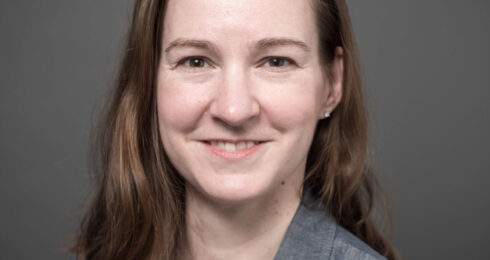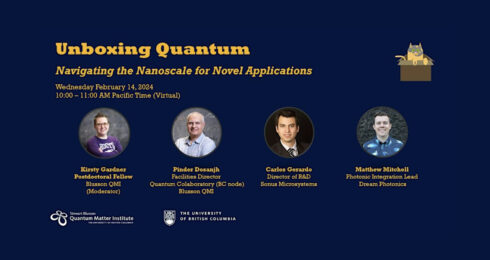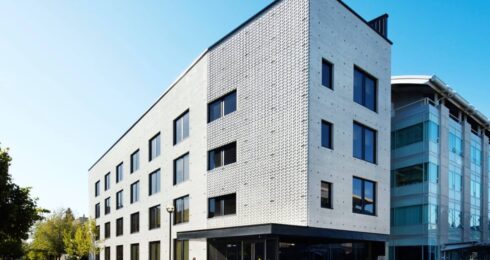In July, QMI welcomed new faculty member Alannah Hallas from Rice University. Now an Assistant Professor in the UBC Physics and Astronomy department, Hallas joined QMI to head the Quantum Materials Design Lab which is currently in its planning and development stage. Having worked in both physics and chemistry, Alannah is passionate about taking an interdisciplinary approach to the study of quantum materials.
,
What does joining QMI mean to your research?
, I was really excited to come work here at QMI because it was a big priority for me to come back to Canada. Also, I love teaching but I knew I wanted to do high-level research. So much of what we do in condensed matter is collaborative, and if you’re by yourself at a smaller university, it can be hard to accomplish much. Here at QMI, we can be more than the sum of our parts.
,
What do you love most about research?
, “I love to discover new materials. Often, that means looking at the literature for what already exists, and trying to see what else is out there. To use a cooking analogy, it’s like working with a recipe that you like. You think of ingredients that you can swap out that will keep the essence of the dish the same. In synthesis, we look for inspiration in terms of crystal structure or different elements that make up that material and then we think about what is chemically similar to that element – and what we might replace it with – in order to create the properties we want to study.”
,
Hallas is referring to a process called crystal growth in which chemical elements are mixed together and heated so that they will undergo a chemical reaction and form a new compound that can have different properties from the starting elements. Hallas’ research focuses on synthesizing bulk samples for quantum materials research. The Quantum Materials Design Lab is the intended location for specialized techniques and instruments that support design-to-order quantum materials synthesis. Hallas’s group will be working closely with that of Meigan Aronson, UBC’s Dean of Science and QMI faculty member, whose approach has also focused on crystal growth.
,
Quantum Materials from a Synthesis Perspective
, While experienced with characterization techniques such as x-ray diffraction, muon spin relaxation, and neutron scattering, Hallas describes herself as a “crystal grower” and solid state chemist.
,
“What I’m drawn to are unusual crystal structures – rare crystal structures that might be formed by only one or two compounds, and I try to understand why that structure is so rare.”
,
What do you look for in the materials you study?
, “When we make a new material, the thing that we’re looking for is interesting magnetic and electronic properties, but we won’t really know its properties until we make it and study it. With the type of research that I do you have to have an openness to finding anything.”
,
“Quantum isn’t really that intuitive for most people, and you have to accept things that you can’t see with the naked eye. It’s a leap. You almost have to forget everything you know and accept a different version of reality.”
,
Could you describe some of the techniques you’ve used?
, “One of my favourite techniques is high pressure synthesis, which I learned during a 3-month research visit to the National Institute for Materials Science in Japan. Normally when we do synthesis, the only thing we’re changing is temperature and composition. High pressure synthesis is like cooking in an Instant Pot instead of on the stove. You’re adding an extra variable, which is pressure. If you imagine it as a graph, you’d have the ingredients along one axis and temperature on another. Pressure adds a third axis. It dramatically expands the number of new materials we might be able to grow.
,
“During my stay in Japan, I got to attempt nearly 100 growths with a 50% success rate. It blew my mind, how much there was to explore. And that’s what we are going to be building at QMI, a high-pressure synthesis apparatus.”
,
How will this technique be used in the Quantum Materials Design lab?
, “Quantum Materials Design Lab is the name of the lab and one of the main instruments we’ll use is a multi-anvil press. It’s essentially a furnace that can also apply pressure, and while it’s uncommon, it has interdisciplinary appeal. It is more widely used in geology research to replicate what’s happening beneath the earth’s surface, but it also has wider applicability and can be used to make new materials – things that don’t exist anywhere on earth. In Canada, there is to my knowledge, just two labs using these types of machines, and they are not studying quantum materials.”
,
While the multi-anvil press is an old technology, its use is rather niche. Hidenori Takagi at the Max Planck Institute for Solid State research (Max Planck ISS) is at the forefront of using this technique in quantum materials research. Max Planck ISS is a long-term QMI collaborator and there is the possibility of further knowledge exchange between MP-QMI groups that share similar techniques.
,
While the Quantum Materials Design Lab is under construction, Alannah will be focused on co-teaching in September, running facility-based experiments, and making plans for the lab.
,
Why grow crystals?
, Polycrystalline materials, such as sand are composed of billions of tiny grains, while single crystals, such as the gemstones used in jewelry, are formed from a single structural domain (essentially, one large grain). Initial studies of polycrystalline samples lay the groundwork for more advanced studies of single crystals, which are usually necessary to fully understand the material’s properties. Many powerful characterization techniques that are already being used at QMI, such as ARPES and STM, require single crystals to extract useful information. When new materials are made there is a greater likelihood of discovering new properties.
,
,

,
,
,
What are your plans for the lab?
, “We’re going to have a wide breadth of crystal growth techniques. We’re going to use flux crystal growth which is a solution-based technique. You combine metals in some ratio, heat them up until they melt and then cool down slowly so that crystals can solidify out of the solution. As a technique, it’s like growing sugar candy on a stick.
,
“Flux growth is something we’re already doing using conventional furnaces, while other parts of the lab are under construction. The apparatus for high pressure synthesis will take time to commission. The press weighs 10,000 pounds and has a 3×3 footprint. The lab area needs to be reinforced to support this weight. The lab itself is just over 2000 square feet, planned for the 2nd floor of the Brimacombe building, and consists of 4 rooms. The renovated lab will provide research space for a dozen or more students and postdocs, 30 conventional furnaces, an x-ray diffractometer, four state-of-the-art instruments for studying the quantum materials we grow, and much more!”
,
“A lot of the tools we use in materials synthesis are related more to chemistry but the problems that motivate me in my research are more from physics. Sometimes we want to study a material’s functional properties, and that involves approaches that traditionally come from materials science or engineering. Because I did my undergrad and masters in chemistry, I take a “chemical” view of things. Using tools and techniques from all these different fields is what taking an interdisciplinary approach means.”
,
,

,
,
,
As for her research goals, Hallas expresses these in modest terms, “I think anyone would be happy if they found a world-changing material that had broad applications but if that material doesn’t exist yet and hasn’t been thought of, then you just have to hope that you can serendipitously stumble on it. Each new material we discover is like a lottery ticket. To make an earth-shattering discovery – you just have to keep your eyes open.”
,
Stewart Blusson QMI warmly welcomes Alannah Hallas and newest group member, research assistant, Graham Johnstone. Graduate student, postdoctoral, and research associate positions are currently available with the Hallas group at UBC.
,
Story: Alannah Hallas with Sophia Han
, Photos: Paul Joseph, Sophia Han


